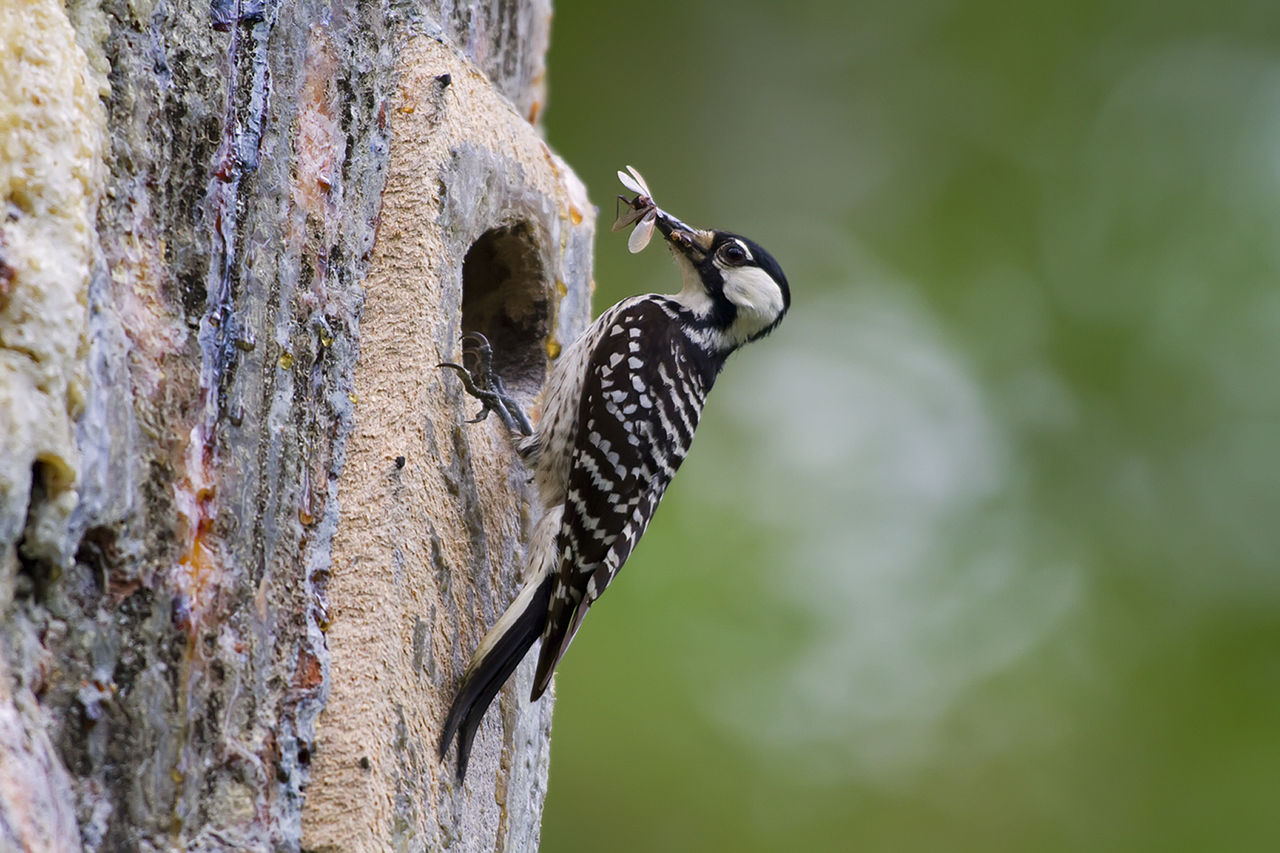LINKED PAPER
Effects of group size and group density on trade-offs in resource selection by a group-territorial central-place foraging woodpecker. Garabedian, J. E., Moorman, C. E., Peterson, M. N., & Kilgo, J. C. 2019. IBIS. DOI: 10.1111/ibi.12733 VIEW
Gathering food is a delicate balancing act for some bird species. They are faced with a trade-off between the quality of the food source and the distance they have to travel (Olsson et al. 2008). This balance is especially important during the breeding seasons when they have to bring food to the nestlings. Birds can make short foraging trips and visit many low quality food patches, or they can travel long distances to obtain high quality food (Caraco et al. 1980). Moreover, foragers might run – or fly – into conspecifics, leading to intense competition for food. These foraging dynamics can be even more complicated in cooperatively breeding species that live in social groups of a breeding pair and several helpers, such as the Red-cockaded Woodpecker (Leuconotopicus borealis).
Foraging trips
James Garabedian and his colleagues studied the behavior of these woodpeckers in South Carolina (USA). They followed the foraging trips of 34 Red-cockaded Woodpecker groups with handheld GPS-devices. The birds prefer the largest and oldest pines in the area, indicating that these trees represent high quality patches (Walters et al. 2002). Statistical analyses of the foraging trips revealed an interesting interaction between group size and group density. When group density was low, all woodpecker groups selected large pine trees far away from the nesting sites. At high group density, however, larger groups still selected large pine trees, whereas smaller groups to foraged close to the nest or searched for low quality food patches (i.e. small or medium pine trees) farther away.

Figure 1 Predicted patterns of habitat use in relation to distance from the nest. At low densities (left figure) all groups forage away from the nest where there are high quality pine trees. At high density (right figure), however, only large groups (dashed line) forage away from the nest, while small groups (solid line) stay close to the nest.
Competition
These results suggest that competition becomes more fierce at high group densities. Larger groups can monopolize high quality food resources and chase away smaller groups. In addition, larger groups can easily find a balance between searching for food and defending the nesting territory. Some individuals will go on foraging trips while others stay at the nest to fend off any intruders (Arnold et al. 2005). Small groups don’t have this luxury and need to forage close to the nest or settle for low quality food patches. These insights can be used in forest management: the presence of a sufficient number of large pines within woodpecker territories will reduce competition between groups, probably leading to a stable and healthy population of Red-cockaded Woodpeckers (Garabedian et al. 2018).
References
Arnold, K.E., Owens, I.P.F. & Goldizen, A.W. (2005). Division of labour within cooperatively breeding groups. Behaviour 142: 1577– 1590. VIEW
Caraco, T., Martindale, S. & Pulliam, H.R. (1980). Avian time budgets and distance to cover. The Auk 97: 872– 875. VIEW
Garabedian, J.E., Moorman, C.E., Peterson, M.N. & Kilgo, J.C. (2018). Relative importance of social factors, conspecific density, and forest structure on space use by the endangered Red‐cockaded Woodpecker: a new consideration for habitat restoration. The Condor 120: 305– 318. VIEW
Olsson, O., Brown, J.S. & Helf, K.L. (2008). A guide to central place effects in foraging. Theoretical Population Biology 74: 22– 33. VIEW
Walters, J.R., Daniels, S.J., Carter, J.H., III & Doerr, P.D. (2002). Defining quality of Red‐cockaded Woodpecker foraging habitat based on habitat use and fitness. Journal of Wildlife Management 66: 1064– 1082. VIEW
Image credits
Featured image: Red-cockaded Woodpecker Leuconotopicus borealis | U.S. Fish and Wildlife Service Southeast Region | CC BY-SA 2.0 Wikimedia Commons




